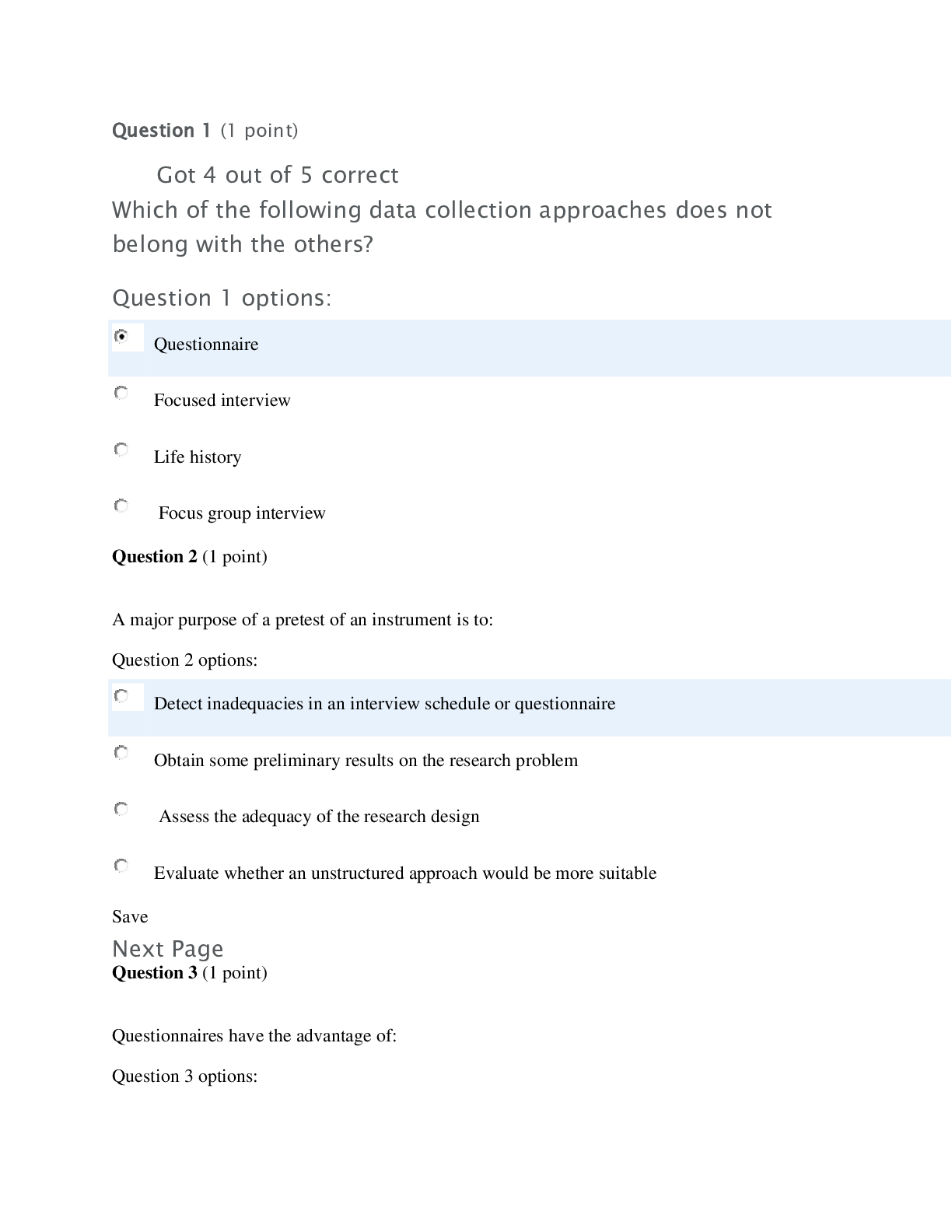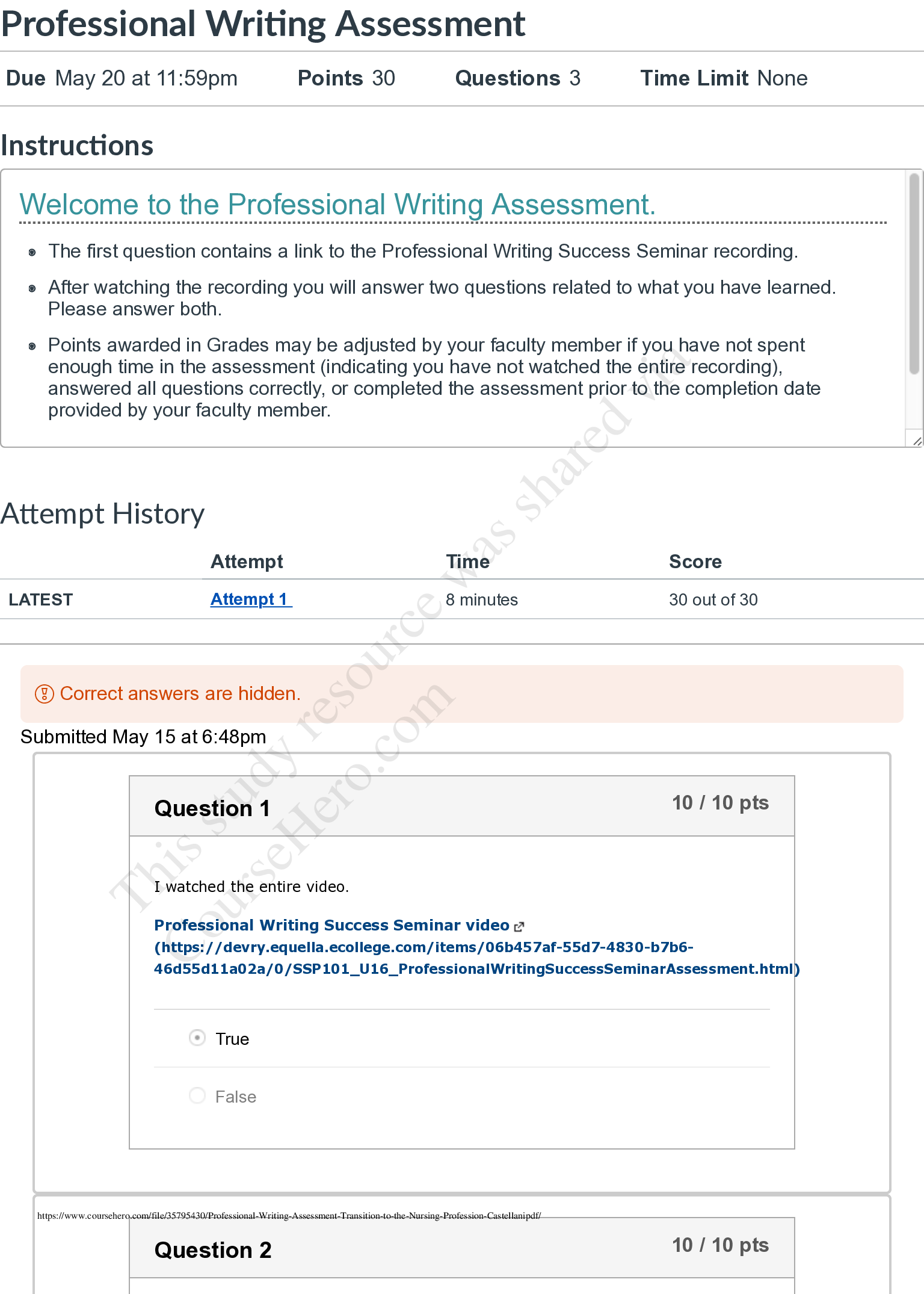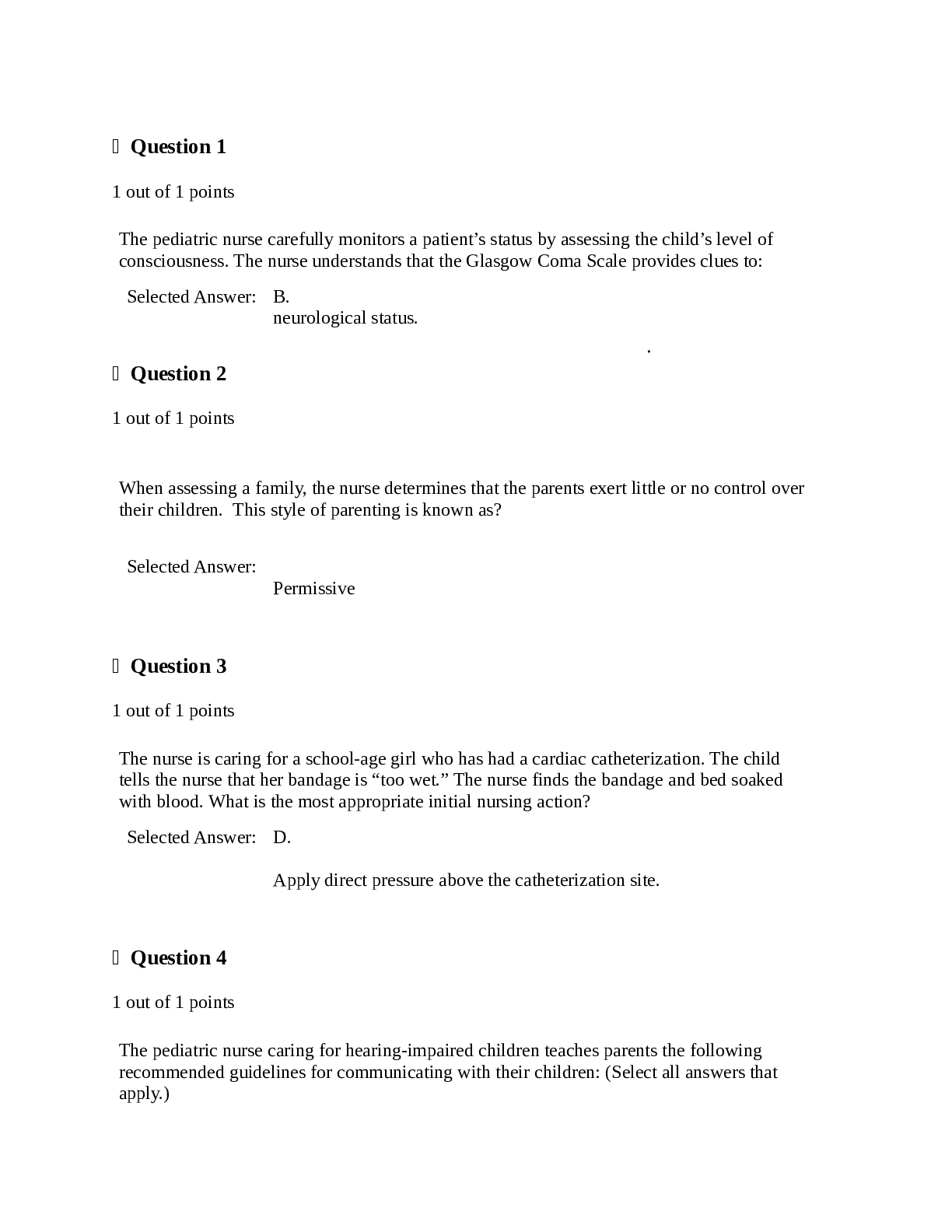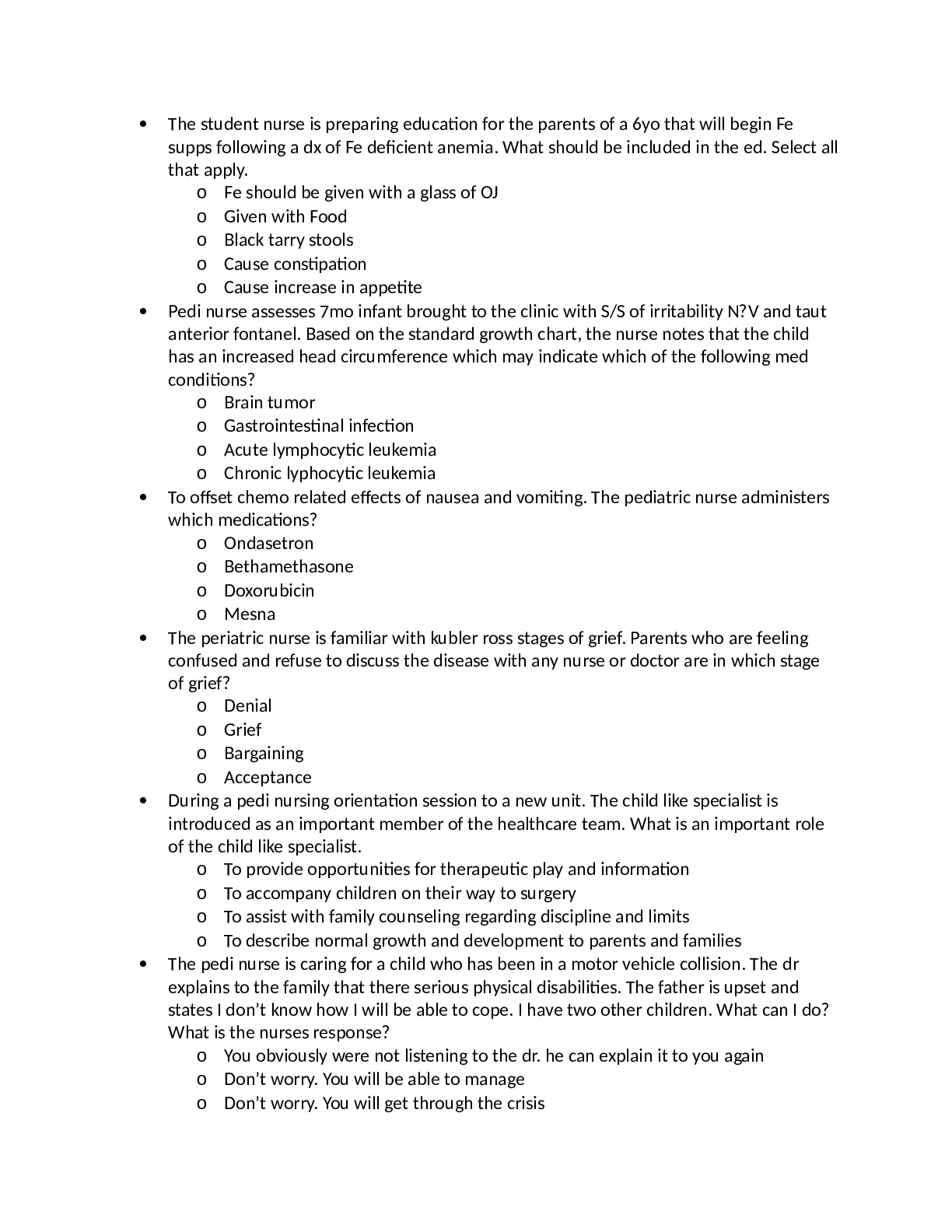Maternal Child Health NUR 2633 Exam 1– Study Guide Test (Latest Version)
Document Content and Description Below
Maternal Child Health NUR 2633 Exam 1– Study Guide Test Maternal Child Health NUR 2633 Exam 1– Study Guide Test 1. Women’s health encompasses breast care, GYN exams, and assessments. Be comfo... rtable with the parameters of education for Self breast exams, normal menstrual cycle - what is the most common complaint with the menstrual cycle, and complications; STI’s and risks. • The most common compliant women have with menstrual cycle is abnormal bleeding, painful menses (dysmenorrhea), treatment is heating pad and NSAIDs. Other OBGYN complaints are fibroids, ovarian cysts, endometriosis. Self breasts exams monthly 7-10 days after the cycle. Two hormones with women’s health are Estrogen(growth hormone makes everything bigger), Progesterone(slows things down, makes lining thicker, the pregnancy will not survive without enough of this hormone) 2. If a patient finds a breast lump how will you advise her? • Its never normal to feel a lump, make sure you follow up and have other testing, discharge is not normal unless it’s a milk discharge after pregnancy 3. What is your role in the GYN exam • Our role in the GYN exam assisting the physician and the patient, explain to her what is happening so she is not nervous, pap smears are never down in the ER 4. Contraception - Forms of birth control – good subject for your postpartum patients as well – know them, know the risks and some of the educational points to share with them regarding each type. Remember birth control choice should be based on a patient’s lifestyle – if she can not swallow pills do not offer oral contraception – right? Etc… • Types of birth control- diaphragm, IUD, the pill, condoms, depo shot, patches, sponge, cervical cap, nuva ring, rod in arm, abstinence, withdrawal, sterilization 5. Emergency contraception – know education. • Plan B used as soon as possible up to 72 hours, doesn’t cause abortion, if your pregnant it won’t hurt the baby, high dose birth control, bad side effects-N/V, headache. 6. Preconceptual care is provided for a means to identify risks and provide nutrition – not to establish who should become pregnant • Identify risk factors, is it safe for them to become pregnant. Healthy nutrition and lifestyle. Weight and folic acid. Immunizations. Are they smoking or drinking? 7. Pregnancy – understand the structure and function of the external and internal genitalia. Know the purpose of each in the process of pregnancy. • Uterus has two functions that are to house the baby and expel it. Vagina is a collapsible tube that stretches to deliver baby. Cervix is usually closed but will thin and open to 10cm to allow baby to come out. Ovaries are egg storage, you start with all the eggs you have, you don’t make new ones. If the Bladder is inflamed, or UTI can cause preterm labor. Bowel, if you have diarrhea, if you use enema or laxative, can start preterm labor. Illegal drugs can also can use preterm labor. Three things uterus needs are food, fluids and rest if it doesn’t have these things if can cause muscle irritation and preterm labor. 8. Please identify pregnancy history – G, F, P, A, L – know how to complete this given each women’s obstetrical history. Gravida- Number of pregnancies Full term pregnancies- Live or dead 37-40 weeks Pre term pregnancies-Live or dead 20-37 weeks Abortion/Miscarriages- Prior to 20 weeks Living- children that are living Twins are one pregnancy 9. What is fetal well- being and how do we measure it. Can you date a pregnancy using Naegele’s Rule? Can you measure fundal height? Know the normal parameters of fetal growth. When are fetal heart tones audible with a Doppler? What are the parameters and what does it mean if the fetus falls outside those parameters • Naegele’s Rule is first day of last missed period subtract 3 months add 7 days and add one year • Fetal well-being is fetal movement, fetal heart tones and fundal height. All moms can feel the baby movement first between 16-20 weeks, primigravida feel it first at 18-20 weeks, it is a butterfly feeling low in the abdomen. Multigravida is 16-18 weeks. • When can we hear fetal heart tones with a Doppler? By 12 weeks because the uterus is coming outside of the pelvis at this time. • Fundal height starts at 14 weeks, it grows with the weeks gestation, we don’t use cm till after 20 weeks, if a mommy is 16 weeks where would we see fundal height? Halfway between the symphysis pubis and the umbilicus, 20 weeks is the umbilicus and 12-14 weeks is the symphysis pubis. We start at the symphysis pubis and measure cm to the top of the uterus. Give or take 2 cm. So if its 28 weeks it could be 26 or 30. If the measure is wrong by more than 2cm the date could be wrong or twins or something else is growing in the uterus. If it is less than 2 cm the date could be wrong, the baby isn’t growing. 10. Fetal development from the conception through the embryonic (critical) period, to the placental development and beyond. – It is all about the placenta. What risk factors will impede placental perfusion to the baby. • A baby is completely developed by 12 weeks, the embryonic stage where you need to be the most cautious about what you put into your body. The pregnancy is tucked away in the pelvis for 12 weeks protecting the baby from trauma. • The placenta is the work organ of pregnancy, if something happens to the placenta it happens to the baby as well. ITS ALL ABOUT PERFUSION. It’s all about the blood flow to and from the placenta. Baby’s blood does not come in contact with mother’s blood. A gas exchange takes place at the chorionic villi, where nutrients and oxygen are given to the baby then the baby gives back carbon dioxide. Carbon dioxide is given to the mother’s lungs to be expelled this makes the mother breathe a little bit faster/deeper. Mother needs more lung capacity, diaphragm pushes on the lungs, so she uses a lateral lung expansion(arches back to receive more lung capacity). • The kidneys need to work harder because the filtration rate is greater because they can’t filter all the extra fluids/salts/proteins. 11. Know normal discomforts of pregnancy and what is not normal and how do nurses educate their patients on the difference. Look at each system. What a normal change means to her and what education you would give • Headaches in pregnancy are NOT normal. A lot of times it is preeclampsia. 12. What activity is appropriate for the pregnant patient? • Walking is best • Don’t start a new exercise you didn’t do before pregnancy 13. Placenta is the ‘work horse’ organ of pregnancy – what does it provide/what it doesn’t provide. • Placenta has two sides the Fetal side and maternal side. o Maternal side(dirty dunkin) has 15-20 tissue pads called Catalina pads(where the gas exchange takes place), count and make sure they’re all there after birth. o Fetal side is the Shiny Schultz side is translucent and you can see through it but you can’t break it without an sharp instrument. • The placenta is made up of two layers of tissue the chorion and amnion. The chorion is on the outside of the balloon and the amnion is on the inside with the baby inside. • The three vessels in the umbilical cord are two arteries(deoxygenated blood baby to mother) and a vein(take oxygenated blood mother to baby). The vessels wrap around each other, to keep the cord from being compressed is Wharton’s jelly. Inside the amnion sac is fluids. The reasons we have fluid are to protect the baby and cord, temperature control and free movement. • Sugar, caffeine, Nicotine, Carbon monoxide and any drugs mom takes crosses the placental barrier, but heparin and insulin do not. 14. Amniotic fluid what is the purpose? What is the issue with oligohydramnios, and polyhydramnios. • Purpose of amniotic fluid is protect fetus and cord from trauma and temperature control. • Oligohydramnios is losing fluid or not enough fluid. • Polyhydramnios is too much fluid. 15. Nutrition is a key factor in pregnancy outcome – what is essential to include. What do most women need additional supplements for? Explore the vegetarian diet. Explore the problem of generalized nausea and vomiting – not severe – explore food fads. What are the risks to the fetus if mom does not gain weight or does not eat properly? And keep in mind the questions regarding the use of alcohol in pregnancy – it is never acceptable. • Drink enough fluids(water) and fiber for constipation • Vegetarian needs to increase protein, iron, folic acid, calcium • IUGR- intrauterine growth restriction, baby doesn’t grow to normal weight during pregnancy. • Mother is diabetic not taking care of herself eating a lot of sugar, baby will be macrosomia(baby grows too much in the trunk). These babies get stuck in the birth canal and causes fetal injuries. • Alcohol is pregnancy is NEVER acceptable 16. Prenatal testing - multiple tests are completed - recognize the difference between a screening exam and a diagnostic exam. Include diagnostic tests such as ultrasounds too. When do we provide them and why? Specifically the labs drawn in the early pregnancy – MSAFP – or the Triple screen when and why drawn, and we know Folic Acid is used to help prevent the development of the Neural Tube and the absence of openings, also the existence of some chromosomal abnormalities – ie: Down syndrome. • RH factor, blood type, CBC, UA, Rubella, Hepatitis, Syphilis, Chlamydia and Gonorrhea cultures, HIV, Varicella titer, Pap smear. • If she is between 15 and 20 weeks we do a Quad screen, this is for genetic testing like Down syndrome or looking for Neural tube defects like spina bifida. • Glucose tolerance test is done between 24 and 28 weeks. • At the end of pregnancy we do a group b strep swab both vagina and rectum(GBS). If mom is positive we need to treat her with antibiotics before the baby is born. 17. Complications of pregnancy – bleeding can be normal or abnormal – what are the causes of both? Know the difference between placenta previa/ placental abruption. What are the risk factors for both? • Bleeding is not normal, always check. • Placenta previa is where the placenta is laying over the cervix(the cervix needs to open during labor to allow the baby to come through), so the placenta can come out first. If this happens the baby can die. This is very serious nothing in the vagina and most likely on bedrest. We need to do an ultrasound, no vaginal ultrasounds. The baby will have to be born by C-section. Placenta previa is PAINLESS bleeding. • Placenta abruption is where the placenta tears away from the uterus which causes PAINFUL bleeding. This can happen because of a trauma like a car accident, cocaine or hypertensive crisis. If blood is filling up in the abdomen it becomes distended, rigid and hard. 18. Preterm labor – know signs and symptoms, treatment, nursing interventions. Know the drugs – that are used as a tocolytic (a drug that stops preterm labor) . • Preterm labor can happen because of smoking malnourishment or recreational drugs. • S/S are cramping, low back ache, increase vaginal discharge, feels like the baby is pushing down. • We lay mom on her left side to give the baby oxygen from the placenta. Hook up the fetal monitor to mom, IV fluids(Lactated Ringers) 500ml bolus minimum, most preterm labor is because of dehydration or UTI. Check UA. Preterm labor would be regular uterine contractions that cause cervical change of 2cm or 80% effaced(thin) before 37 weeks. Fetal fibronectin(fFN) is a test can show if your body is getting ready to give birth. Also do a vaginal ultrasound to check cervix it should be 4cm in length if not she could be in preterm labor. If mom continues to contract we would give her Terbutaline subcut, if that doesn’t work we give Magnesium Sulfate 4g bolus then 2 g maintenance. Mag sulfate works on the smooth muscle to relax it. This can relax diaphragm so we must listen to lung sounds. Vital signs, output, DTR(deep tendon reflexes) every hour. Baby will need NICU to watch the breathing. 19. Pre – eclampsia – know signs and symptoms (subjective and objective), treatment and nursing interventions. • Pre-eclampsia usually seen after 24 weeks. S/S is Hypertension, edema and proteinuria. Can affect the brain, heart, liver and kidneys. If mom comes in with higher than normal blood pressure lay her on her LEFT SIDE. Mom is going to have headache, heartburn, epigastric pain, vision problems, pitting edema and high BP. Hook her up to monitor. Give her Mag sulfate 4g bolus and 2g maintenance. Keep Mag on 24 hours post delivery. This is to prevent or treat the seizures because it’s a smooth muscle relaxant. Put in a foley catheter, to see how much urine she is putting out. She will start out with less than 30ml/hr until the mag starts working and relaxes. Cure for pre-eclampsia is to have the baby and placenta. We have to give Oxytocin to go into labor because the mag stops this process. • Mom is now at risk for postpartum hemorrhage because the uterus doesn’t contract after birth because of the mag sulfate. We need to keep the Pitocin(oxytocin) running after birth to get that uterus to contract. If we have a boggy uterus then we need to massage the fundus. 20. Know the medications used in pregnancy both the normal supplementation and those used to manage preterm labor and pre eclampsia. • Betamethasone is a steroid that is given to help fetal lung maturity, given 24-34 weeks for preterm labor • Magnesium Sulfate is a muscle relaxant for preterm labor and preeclampsia. 4g bolus and 2g maintenance. • Terbutaline is a tocolytic in treatment of preterm labor to stop uterine contractions before 37 weeks. 3 times an hour, can cause cardiac issues • Oxytocin(Pitocin) strengthen labor contractions used during preeclampsia 21. Know specifically magnesium sulfate since it is used for both reasons – preterm labor and pre eclampsia due to the effect – it is a smooth muscle relaxant – hence the uterus is a smooth muscle and will respond well to the drug – your blood vessels and the tissue surrounding relax hence having a hypotensive response if using Mag. Please know magnesium well. It is the first line defense in pre eclampsia….not to prevent hypertension but to……..?? This info in in with preeclampsia and preterm labor 22. What is the effect on the baby of the risk factors that may impede placental perfusion? Two things can happen if the placenta is insulted, IUGR(Intrauterine growth restriction) and macrosomia. 23. Diabetes in pregnancy is a big problem. Know the differences of fetal surveillance with Type 1 vs Type 2, vs Gestational DM – what is the risk to the baby. • Type 1 Diabetes means the pancreas is not working is not producing insulin. Type 1 can cause defects including ventricular septal defect, skeletal issues and neuro issues. • Type 2 is managed by diet or insulin. Type 2 no anomalies but at risk for macrosomia. • Gestational Diabetes unless other signs we do not look for this until 24-28 weeks, this is diet control with fasting blood sugar to be 60-90. Gestational DM can cause macrosomia. Gestational diabetes don’t have the risk of anomalies. • Whenever insulin is given the perfusion is at risk and we need to watch the fetus carefully with a non-stress test. We don’t want the baby to be big so we may need to deliver early, need to check for lung maturity with a L/S ratio. Watch blood sugar for baby post delivery, hypoglycemia. 24. Hyperemesis Gravidarum - a problem of extreme nausea and vomiting causing electrolyte imbalance , dehydration and severe weight loss – what is the nursing intervention? • Hyperemesis Gravidarum usually during the first trimester. May need IV therapy for the dehydration. Eat small more frequent meals. Antiemetic for the N/V. 25. Do you understand the concept of perfusion, oxygenation, the hormone feedback system, and the responses of the body under the hormone influences? You will do well. • Turn mom on LEFT Side for best perfusion to the placenta • RBCs go down, plasma goes up, platelets stay the same, WBCs go up because there is a foreign body inside, H&H goes down, GFR goes up, thyroid goes up • In the second trimester the blood pressure drops, we become anemic, increased heart rate. Third trimester the blood pressure comes back up, if it goes high then we think preeclampsia. [Show More]
Last updated: 1 year ago
Preview 1 out of 6 pages
Instant download
Buy this document to get the full access instantly
Instant Download Access after purchase
Add to cartInstant download
Reviews( 0 )
Document information
Connected school, study & course
About the document
Uploaded On
Mar 09, 2021
Number of pages
6
Written in
Additional information
This document has been written for:
Uploaded
Mar 09, 2021
Downloads
0
Views
30





.png)









